 So, here we are at the end of June, another month gone by in lock-down, and my bees have never had it so good! The weather has been superb, in the main, with a tremendous honey-flow on and all that lovely unpolluted air – and our glorious wild-flower meadow has been a joy to behold! Well worth all the hard work that went into it, with the bees having a wonderful time as a result.
So, here we are at the end of June, another month gone by in lock-down, and my bees have never had it so good! The weather has been superb, in the main, with a tremendous honey-flow on and all that lovely unpolluted air – and our glorious wild-flower meadow has been a joy to behold! Well worth all the hard work that went into it, with the bees having a wonderful time as a result.
May and June are the two main months normally set aside (by the bees!) for swarming each year but this year I have had only three of my home colonies swarm, though I have collected three swarms from other people’s colonies around the Roseland.
The swarm I collected from a fellow-beekeeper, who had run out of equipment, turned out to be a cast, as I suspected at the time but the virgin queen having mated (hopefully with some of my Cornish black drones) is in full swing laying eggs at a tremendous rate. Time alone will tell whether or not the Cornish genes have been passed on.
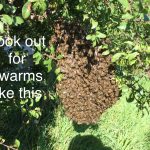 You may remember that last month I also told you about the swarm which I came across when I was mowing the apiary field. On examination of the parent colony I found no brood in any stage, ie no eggs, no larvae and no sealed brood (the pupal stage of development) and though the bees that were left behind were well-behaved and seemed quite happy, I attributed the departure of the swarm with the old queen to the fact that the hive was honey-bound. I decided to go with my instincts at the time, viz that since the bees weren’t too bothered about the situation they found themselves in then perhaps nor should I be. I gave them a frame of open brood from another colony and left them to it, in the knowledge that should I find them without queen cells in a week’s time then there was a queen present, even if I couldn’t find her. This indeed turned out to be the case.
You may remember that last month I also told you about the swarm which I came across when I was mowing the apiary field. On examination of the parent colony I found no brood in any stage, ie no eggs, no larvae and no sealed brood (the pupal stage of development) and though the bees that were left behind were well-behaved and seemed quite happy, I attributed the departure of the swarm with the old queen to the fact that the hive was honey-bound. I decided to go with my instincts at the time, viz that since the bees weren’t too bothered about the situation they found themselves in then perhaps nor should I be. I gave them a frame of open brood from another colony and left them to it, in the knowledge that should I find them without queen cells in a week’s time then there was a queen present, even if I couldn’t find her. This indeed turned out to be the case.
During that examination a week later, I found there were no queen cells drawn on the brood frame I had given them which indicated there was a queen present – and finally, on checking through the frames, slowly and very carefully, I found her! What a relief to me that was, mainly in time-saving. The colony once more is building up and appears to be prospering as I would expect after losing a swarm, so the bees and I are well-pleased.
I noticed bees investigating my tree bait hive shortly after this and expected the swarm to come from another of my polystyrene nucleus hives, which I had deliberately left so that they would swarm so that I could split it into two or three new nuclei. When the bees eventually arrived in the bait hive, I decided to perform an artificial swarm on them. Click video link IMG_3222-1
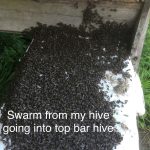 An artificial swarm is a manipulation whereby the swarm is placed on the site of the parent colony (from which the swarm came) and the parent colony is moved to another position in the apiary. To achieve this I had to take the bait hive down from the tree it was in (after first closing the entrance so the bees could not escape!). This is no simple task, up a 12’ ladder at dusk after the bees have stopped flying, manipulating a hive of bees, the weight of which has to be felt to be believed! But down I got it, placed it on the site where they came from, having closed up the nuc and moved that to a new position, and left both hives until the following day, when I would open the entrances and let the bees do what they naturally would do. Since some bees had oriented to the bait hive whilst it was in the tree, I did not want to leave the entrance open after moving it out of the tree because the oriented bees would fly back there, so I did what I did during a winter hive-move, I stuffed the entrance with grass. This makes the bees fight their way out of the hive through the grass, realising something different has taken place, and orientate to the new position, forgetting about the original position in the tree – only the bees found another way out of the hive, so some of them went back to the tree anyway!
An artificial swarm is a manipulation whereby the swarm is placed on the site of the parent colony (from which the swarm came) and the parent colony is moved to another position in the apiary. To achieve this I had to take the bait hive down from the tree it was in (after first closing the entrance so the bees could not escape!). This is no simple task, up a 12’ ladder at dusk after the bees have stopped flying, manipulating a hive of bees, the weight of which has to be felt to be believed! But down I got it, placed it on the site where they came from, having closed up the nuc and moved that to a new position, and left both hives until the following day, when I would open the entrances and let the bees do what they naturally would do. Since some bees had oriented to the bait hive whilst it was in the tree, I did not want to leave the entrance open after moving it out of the tree because the oriented bees would fly back there, so I did what I did during a winter hive-move, I stuffed the entrance with grass. This makes the bees fight their way out of the hive through the grass, realising something different has taken place, and orientate to the new position, forgetting about the original position in the tree – only the bees found another way out of the hive, so some of them went back to the tree anyway!
Ah well! Best laid plans of mice and men, etc! So I opened the entrance on both hives to allow the bees from the nuc to fly back to their original site (where the swarm was now installed) and augment the bees in the swarm. After an hour or so, I opened up the nuc to see how many queen cells were present – none! The swarm hadn’t come from that hive after all! That didn’t stop the bees from the nuc joining the swarm though, it just made for a much bigger colony than I had expected. I made up a smaller nuc using the queen and moved them to a new site in the apiary and whilst the swarm was happy (lots of bees), the nuc, now queenless, just got on with the job of making replacement queen cells. Once built, I then did the split I was always planning to do and have my three nucs doing their utmost to build up in time for winter. So where did the swarm come from? My Warré hive! I don’t take honey from this hive and just let them do their own thing – so they did!
No sooner had I sorted out the swarm in the bait hive and transferred the bees to their proper home and replaced the bait hive in the tree, than another swarm took up residence in it, so off I go again! Any more swarms, methinks, will just have to be united with an existing swarm and they’ll have to share accommodation!
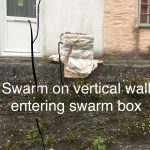 A week later, I had a FaceBook Message from a friend telling me there was a swarm in the road at the bottom of Tregony Hill. So off I go to Tregony. I walked up one side of the hill, asking locals that I met if they had seen a swarm (“No?!”), looking in every tree, roof, garage, garden, shed – residents must have thought I was casing their properties! – but no sign of any swarm. I then proceeded down Tregony Hill on the other side, repeating my “casing” activities, when suddenly my head was in a cloud of bees! I’d found it! The swarm was clinging to a vertical wall in the sun (so lovely and warm for them) that supported a path that gave access to three terraced cottages. I could have brushed the bees into my swarm box but they would have flown everywhere. More to the point the bee numbers looked so small as to indicate another cast and, virgins being the fickle beeings they are, would likely have flown off, never to be seen again. I therefore placed my swarm box on the top edge of the wall, above the clustered bees, and left them to it.
A week later, I had a FaceBook Message from a friend telling me there was a swarm in the road at the bottom of Tregony Hill. So off I go to Tregony. I walked up one side of the hill, asking locals that I met if they had seen a swarm (“No?!”), looking in every tree, roof, garage, garden, shed – residents must have thought I was casing their properties! – but no sign of any swarm. I then proceeded down Tregony Hill on the other side, repeating my “casing” activities, when suddenly my head was in a cloud of bees! I’d found it! The swarm was clinging to a vertical wall in the sun (so lovely and warm for them) that supported a path that gave access to three terraced cottages. I could have brushed the bees into my swarm box but they would have flown everywhere. More to the point the bee numbers looked so small as to indicate another cast and, virgins being the fickle beeings they are, would likely have flown off, never to be seen again. I therefore placed my swarm box on the top edge of the wall, above the clustered bees, and left them to it.
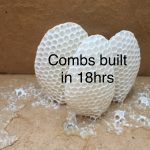 That evening I returned and collected the box (the bees were all inside) and next day hived them into a nuc box in the apiary – but in the 18 hours they had been in my swarm box they built three beautiful palm-sized combs! Very industrious!
That evening I returned and collected the box (the bees were all inside) and next day hived them into a nuc box in the apiary – but in the 18 hours they had been in my swarm box they built three beautiful palm-sized combs! Very industrious!
They, like all my other bees, are going great guns with all the fine weather we’ve been having.
Finally, a heads-up on my bait hive on my friend’s shed roof – there are scout bees investigating, so there might be yet another swarm coming my way shortly – but don’t count your bees until they’re in the hive!!!
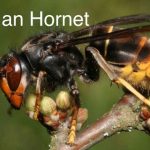 So, keep your eyes open for swarms and Asian Hornets.
So, keep your eyes open for swarms and Asian Hornets.
There have been possible, but not confirmed, sightings of the latter in Gorran Haven and Fowey, so getting a little too close for comfort if confirmed but I’ll keep you posted on any developments. I am still getting calls regarding swarms, most of which are outside my parish so I can pass them on, but it’s still swarming season, so keep a look-out and contact me if you see one.
 I’ll ensure it is collected, either by me or another beekeeper – we don’t want bees ending up in your chimney or roof-space!
I’ll ensure it is collected, either by me or another beekeeper – we don’t want bees ending up in your chimney or roof-space!
Colin Rees 07939 971104 01872 501313 colinbeeman@aol.com

